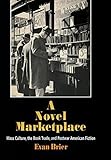A Novel Marketplace : Mass Culture, the Book Trade, and Postwar American Fiction / Evan Brier.
Material type: TextPublisher: Philadelphia : University of Pennsylvania Press, [2012]Copyright date: ©2010Description: 1 online resource (224 p.)Content type:
TextPublisher: Philadelphia : University of Pennsylvania Press, [2012]Copyright date: ©2010Description: 1 online resource (224 p.)Content type: - 9780812242072
- 9780812201444
- American fiction -- 20th century -- History and criticism
- Authors and publishers -- United States -- History -- 20th century
- Fiction -- Publishing -- United States -- History -- 20th century
- Literature publishing -- Economic aspects -- United States -- History -- 20th century
- Cultural Studies
- LITERARY CRITICISM / American / General
- Cultural Studies
- Literature
- 813/.5409 22
- PS379 .B675 2010eb
- online - DeGruyter
- Issued also in print.
| Item type | Current library | Call number | URL | Status | Notes | Barcode | |
|---|---|---|---|---|---|---|---|
 eBook
eBook
|
Biblioteca "Angelicum" Pont. Univ. S.Tommaso d'Aquino Nuvola online | online - DeGruyter (Browse shelf(Opens below)) | Online access | Not for loan (Accesso limitato) | Accesso per gli utenti autorizzati / Access for authorized users | (dgr)9780812201444 |
Frontmatter -- Contents -- Introduction: Selling the Novel in the Age of Mass Culture -- Chapter 1. Constructing the Postwar Art Novel: The Making and Marketing of The Sheltering Sky -- Chapter 2. The "Incalculable Value of Reading": Fahrenheit 451 and the Paperback Assault on Mass Culture -- Chapter 3. Synergy and the Novelist: Simon & Schuster; Time, Inc.; and The Man in the Gray Flannel Suit -- Chapter 4. From Novel to Blockbuster: Peyton Place and the Narrative of Cultural Decline -- Chapter 5. 1959 and Beyond: Mergers, Acquisitions, and Norman Mailer -- Epilogue: Novels Today: Oprah Winfrey, Jonathan Franzen, and the Long Tail -- Notes -- Works Cited -- Index -- Acknowledgments
restricted access online access with authorization star
http://purl.org/coar/access_right/c_16ec
As television transformed American culture in the 1950s, critics feared the influence of this newly pervasive mass medium on the nation's literature. While many studies have addressed the rhetorical response of artists and intellectuals to mid-twentieth-century mass culture, the relationship between the emergence of this culture and the production of novels has gone largely unexamined.In A Novel Marketplace, Evan Brier illuminates the complex ties between postwar mass culture and the making, marketing, and reception of American fiction. Between 1948, when television began its ascendancy, and 1959, when Random House became a publicly owned corporation, the way American novels were produced and distributed changed considerably. Analyzing a range of mid-century novels-including Paul Bowles's The Sheltering Sky, Ray Bradbury's Fahrenheit 451, Sloan Wilson's The Man in the Gray Flannel Suit, and Grace Metalious's Peyton Place-Brier reveals the specific strategies used to carve out cultural and economic space for the American novel just as it seemed most under threat. During this anxious historical moment, the book business underwent an improbable expansion, by capitalizing on an economic boom and a rising population of educated consumers and by forming institutional alliances with educators and cold warriors to promote reading as both a cultural and political good.A Novel Marketplace tells how the book trade and the novelists themselves successfully positioned their works as embattled holdouts against an oppressive mass culture, even as publishers formed partnerships with mass-culture institutions that foreshadowed the multimedia mergers to come in the 1960s. As a foil for and a partner to literary institutions, mass media corporations assisted in fostering the novel's development as both culture and commodity.
Issued also in print.
Mode of access: Internet via World Wide Web.
In English.
Description based on online resource; title from PDF title page (publisher's Web site, viewed 24. Apr 2022)


